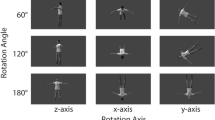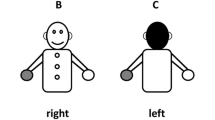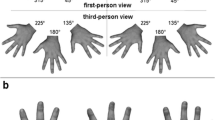Abstract
The right temporoparietal cortex plays a critical role in body representation. Here, we applied repetitive transcranial magnetic stimulation (rTMS) over right extrastriate body area (EBA) and temporoparietal junction (TPJ) to investigate their causative roles in perceptual representations of one’s own and others’ body. Healthy women adjusted size-distorted pictures of their own body or of the body of another person according to how they perceived the body (subjective task) or how others perceived it (intersubjective task). In keeping with previous reports, at baseline, we found an overall underestimation of body size. Crucially, EBA-rTMS increased the underestimation bias when participants adjusted the images according to how others perceived their own or the other woman’s body, suggesting a specific role of EBA in allocentric body representations. Conversely, TPJ-rTMS increased the underestimation bias when participants adjusted the body of another person, either a familiar other or a close friend, in both subjective and intersubjective tasks, suggesting an involvement of TPJ in representing others’ bodies. These effects were body-specific, since no TMS-induced modulation was observed when participants judged a familiar object. The results suggest that right EBA and TPJ play active and complementary roles in the complex interaction between the perceptions of one’s own and other people’s body.






Similar content being viewed by others
References
Aleong, R., & Paus, T. (2010). Neural correlates of human body perception. Journal of Cognitive Neuroscience, 22, 482–495.
Alleva, J., Jansen, A., Martijn, C., Schepers, J., & Nederkoorn, C. (2013). Get your own mirror: Investigating how strict eating disordered women are in judging the bodies of other eating disordered women. Appetite, 68, 98–104.
Arzy, S., Thut, G., Mohr, C., Michel, C. M., & Blanke, O. (2006). Neural basis of embodiment: Distinct contributions of temporoparietal junction and extrastriate body area. Journal of Neuroscience, 26, 8074–8081.
Avenanti, A., Annella, L., Candidi, M., Urgesi, C., & Aglioti, S. M. (2012). Compensatory plasticity in the action observation network: Virtual lesions of STS enhance anticipatory simulation of seen actions. Cerebral Cortex, 23, 570–580.
Beauchamp, M. S., Lee, K. E., Haxby, J. V., & Martin, A. (2002). Parallel visual motion processing streams for manipulable objects and human movements. Neuron, 34, 149–159.
Berlucchi, G., & Aglioti, S. M. (1997). The body in the brain: Neural bases of corporeal awareness. Trends in Neurosciences, 20, 560–564.
Blanke, O., Landis, T., Spinelli, L., & Seeck, M. (2004). Out-of-body experience and autoscopy of neurological origin. Brain, 127, 243–258.
Blanke, O., Ortigue, S., Landis, T., & Seeck, M. (2002). Stimulating illusory own-body perceptions. Nature, 419, 269–270.
Botvinick, M., & Cohen, J. (1998). Rubber hands “feel” touch that eyes see. Nature, 391, 6669–6756.
Briggs, G. G., & Nebes, R. D. (1975). Patterns of hand preference in a student population. Cortex, 11, 230–238.
Brown, F. L., & Slaughter, V. (2011). Normal body, beautiful body: Discrepant perceptions reveal a pervasive “thin ideal” from childhood to adulthood. Body Image, 8, 119–125.
Castellini, G., Polito, C., Bolognesi, E., D’Argenio, A., Ginestroni, A., Mascalchi, M., & Ricca, V. (2013). Looking at my body. Similarities and differences between anorexia nervosa patients and controls in body image visual processing. European Psychiatry, 28, 427–435.
Cattarin, J. A., Thompson, J. K., Thomas, C., & Williams, R. (2000). Body image, mood, and televised images of attractiveness: The role of social comparison. Journal of Social and Clinical Psychology, 19, 220–239.
Cazzato, V., Mele, S., & Urgesi, C. (2014). Gender differences in the neural underpinning of perceiving and appreciating the beauty of the body. Behavioral Brain Research, 264, 188–196.
Chan, A. W., Peelen, M. V., & Downing, P. E. (2004). The effect of viewpoint on body representation in the extrastriate body area. NeuroReport, 15, 2407–2410.
Chen, R. (1997). Depression of motor cortex excitability by low-frequency transcranial magnetic stimulation. Neurology, 48, 1398–1403.
Cooper, P. J., Taylor, M. J., Cooper, Z., & Fairburn, C. (1987). The development and validation of the body shape questionnaire. International Journal of Eating Disorders, 6, 485–494.
Costantini, M., Urgesi, C., Galati, G., Romani, G. L., & Aglioti, S. M. (2011). Haptic perception and body representation in lateral and medial occipito-temporal cortices. Neuropsychologia, 49, 821–829.
Craig, A. D. (2010). The sentient self. Brain Structure and Function, 214, 563–577.
Decety, J., & Lamm, C. (2007). The role of the right temporoparietal junction in social interaction: How low-level computational processes contribute to meta-cognition. The Neuroscientist, 13, 580–593.
Downing, P. E., Peelen, M. V., Wiggett, A. J., & Tew, B. D. (2006a). The role of the extrastriate body area in action perception. Social Neuroscience, 1, 52–62.
Downing, P. E., & Peelen, M. V. (2011). The role of occipitotemporal body-selective regions in person perception. Cognitive Neuroscience, 2, 186–203.
Downing, P. E., Chan, A. W., Peelen, M. V., Dodds, C. M., & Kanwisher, N. (2006b). Domain specificity in visual cortex. Cerebral Cortex, 16, 1453–1461.
Downing, P. E., Jiang, Y., Shuman, M., & Kanwisher, N. (2001). A cortical area selective for visual processing of the human body. Science, 293, 2470–2473.
Downing, P. E., Wiggett, A. J., & Peelen, M. V. (2007). Functional magnetic resonance imaging investigation of overlapping lateral occipitotemporal activations using multi-voxel pattern analysis. Journal of Neuroscience, 27, 226–233.
Fernandez, S., & Pritchard, M. (2012). Relationships between self-esteem, media influence and drive for thinness. Eating Behaviors, 13, 321–325.
Friederich, H. C., Uher, R., Brooks, S., Giampietro, V., Brammer, M., Williams, S. C., & Campbell, I. C. (2007). I’m not as slim as that girl: Neural bases of body shape self-comparison to media images. NeuroImage, 37, 674–681.
Friederich, H. C., Brooks, S., Uher, R., Campbell, I. C., Giampietro, V., Brammer, M., & Treasure, J. (2010). Neural correlates of body dissatisfaction in anorexia nervosa. Neuropsychologia, 48, 2878–2885.
Garner, D. (1984). Eating Disorder Inventory–2. Florence, Italy: Organizzazioni Special.
Grossman, E. D., & Blake, R. (2002). Brain areas active during visual perception of biological motion. Neuron, 35, 1167–1175.
Heinisch, C., Krüger, M. C., & Brüne, M. (2012). Repetitive transcranial magnetic stimulation over the temporoparietal junction influences distinction of self from famous but not unfamiliar others. Behavavioral Neuroscience, 126, 792–796.
Hodzic, A., Kaas, A., Muckli, L., Stirn, A., & Singer, W. (2009a). Distinct cortical networks for the detection and identification of human body. NeuroImage, 45, 1264–1271.
Hodzic, A., Muckli, L., Singer, W., & Stirn, A. (2009b). Cortical responses to self and others. Human Brain Mapping, 30, 951–962.
Jackson, P. L., Brunet, E., Meltzoff, A. N., & Decety, J. (2006). Empathy examined through the neural mechanisms involved in imagining how I feel versus how you feel pain: An event-related fMRI study. Neuropsychologia, 44, 752–761.
Jansen, A., Smeets, T., Martijn, C., & Nederkoorn, C. (2006). I see what you see: The lack of a self-serving body-image bias in eating disorders. British Journal of Clinical Psychology, 45, 123–135.
Kriegeskorte, N., Formisano, E., Sorger, B., & Goebel, R. (2007). Individual faces elicit distinct response patterns in human anterior temporal cortex. Proceedings of the National Academy of Sciences, 104, 20600–20605.
Lamm, C., Batson, C. D., & Decety, J. (2007). The neural basis of human empathy: Effects of perspective-taking and cognitive appraisal. Journal of Cognitive Neuroscience, 19, 42–58. doi:10.1162/jocn.2007.19.1.42
Lawrence, E. J., Shaw, P., Giampietro, V. P., Surguladze, S., Brammer, M. J., & David, A. S. (2006). The role of “shared representations” in social perception and empathy: An fMRI study. NeuroImage, 29, 1173–1184.
Legenbauer, T., Vocks, S., Betz, S., Báguena Puigcerver, M. J., Benecke, A., Troje, N. F., & Rüddel, H. (2011). Differences in the nature of body image disturbances between female obese individuals with versus without a comorbid binge eating disorder: An exploratory study including static and dynamic aspects of body image. Behavioral Modification, 35, 162–186.
Leube, D. T., Knoblich, G., Erb, M., Grodd, W., Bartels, M., & Kircher, T. T. (2003). The neural correlates of perceiving one’s own movements. NeuroImage, 20, 2084–2090.
Maguire, E. A., Burgess, N., Donnett, J. G., Frackowiak, R. S., Frith, C. D., & O’Keefe, J. (1998). Knowing where and getting there: A human navigation network. Science, 280, 921–924.
Marini, A., & Urgesi, C. (2012). Please get to the point! A cortical correlate of linguistic informativeness. Journal of Cognitive Neuroscience, 24, 2211–2222.
Mele, S., Cazzato, V., & Urgesi, C. (2013). The importance of perceptual experience in the esthetic appreciation of the body. PLoS ONE, 8, e81378. doi:10.1371/journal.pone.0081378
Mian, E., & Gerbino, W. (2009). Body image assessment in the computer aided psychological support for eating disorders. Abstracts from cyber therapy 14, designing the future of healthcare, Lago Maggiore, Verbania, Italy. Cyber Psychology & Behavior, 12, 581--673.
Miyake, Y., Okamoto, Y., Onoda, K., Kurosaki, M., Shirao, N., Okamoto, Y., & Yamawaki, S. (2010). Brain activation during the perception of distorted body images in eating disorders. Psychiatry Research, 30, 183–192.
Mohr, C., Porter, G., & Benton, C. P. (2007). Psychophysics reveals a right hemispheric contribution to body image distortions in women but not men. Neuropsychologia, 45, 2942–2950.
Mohr, H. M., Röder, C., Zimmermann, J., Hummel, D., Negele, A., & Grabhorn, R. (2011). Body image distortions in bulimia nervosa: investigating body size overestimation and body size satisfaction by fMRI. NeuroImage, 56, 1822–1831.
Mohr, H. M., Zimmermann, J., Röder, C., Lenz, C., Overbeck, G., & Grabhorn, R. (2010). Separating two components of body image in anorexia nervosa using fMRI. Psychological Medicine, 40, 1519–1529.
Moro, V., Urgesi, C., Pernigo, S., Lanteri, P., Pazzaglia, M., & Aglioti, S. M. (2008). The neural basis of body form and body action agnosia. Neuron, 23, 235–246.
Peelen, M. V., & Downing, P. E. (2007). The neural basis of visual body perception. Nature Reviews Neuroscience, 8, 636–648.
Probst, M., Vandereycken, W., Van Coppenolle, H., & Vanderlinden, J. (1995). The body attitude test for patients with an eating disorder: Psychometric characteristics of a new questionnaire. Eating Disorders, 3, 133–144.
Rivadeneyra, R., Ward, L. M., & Gordon, M. (2007). Distorted reflections: Media exposure and Latino adolescents’ conceptions of self. Media Psychology, 9, 261–290.
Rossi, S., Hallett, M., Rossini, P. M., & Pascual-Leone, A. (2009). Safety, ethical considerations, and application guidelines for the use of transcranial magnetic stimulation in clinical practice and research. Clinical Neurophysiology, 120, 2008–2039.
Ruby, P., & Decety, J. (2003). What you believe versus what you think they believe? A neuroimaging study of conceptual perspective taking. European Journal of Neuroscience, 17, 2475–2480.
Saxe, R. (2006). Uniquely human social cognition. Current Opinion in Neurobiology, 16, 235–239.
Saxe, R., Jamal, N., & Powell, L. (2006). My body or yours? The effect of visual perspective on cortical body representations. Cerebral Cortex, 16, 178–182.
Saxe, R., & Wexler, A. (2005). Making sense of another mind: the role of the right temporo-parietal junction. Neuropsychologia, 43, 1391–1399.
Schwoebel, J., & Coslett, H. B. (2005). Evidence for multiple, distinct representations of the human body. Journal of Cognitive Neuroscience, 17, 543–553.
Speer, A. M., Willis, M. W., Herscovitch, P., Daube-Witherspoon, M., Shelton, J. R., Benson, B. E., & Wassermann, E. M. (2003). Intensity-dependent regional cerebral blood flow during 1-Hz repetitive Transcranial magnetic stimulation (rTMS) in healthy volunteers studied with H215O positron emission tomography: II. Effects of prefrontal cortex rTMS. Biological Psychiatry, 54, 826–832.
Suchan, B., Bauser, D. S., Busch, M., Schulte, D., Grönemeyer, D., Herpertz, S., & Vocks, S. (2013). Reduced connectivity between the left fusiform body area and the extrastriate body area in anorexia nervosa is associated with body image distortion. Behavioural Brain Research, 15, 80–85.
Suchan, B., Busch, M., Schulte, D., Grönemeyer, D., Herpertz, S., & Vocks, S. (2010). Reduction of gray matter density in the extrastriate body area in women with anorexia nervosa. Behavioural Brain Research, 5(206), 63–67.
Talairach, J., & Tournoux, P. (1988). Co-planar stereotaxic atlas of the human brain: 3-dimensional proportional system—An approach to cerebral imaging. New York, NY: Thieme.
Taylor, S. E., & Brown, J. D. (1994). Positive illusions and well-being revisited: Separating fact from fiction. Psychology Bulletin, 116, 21–27.
Thompson, J. K. (2004). The (mis)measurement of body image: Ten strategies to improve assessment for applied and research purposes. Body Image, 1, 7–14.
Trampe, D., Stapel, D. A., & Siero, F. W. (2007). On models and vases: Body dissatisfaction and proneness to social comparison effects. Journal Personality Social Psychology, 92, 106–118.
Tsakiris, M., Costantini, M., & Haggard, P. (2008). The role of the right temporo-parietal junction in maintaining a coherent sense of one’s body. Neuropsychologia, 46, 3014–3018.
Uddin, L. Q., Molnar-Szakacs, I., Zaidel, E., & Iacoboni, M. (2006). rTMS to the right inferior parietal lobule disrupts self–other discrimination. Social Affective Cognitive Neuroscience, 1, 65–71.
Uher, R., Murphy, T., Friederich, H. C., Dalgleish, T., Brammer, M. J., Giampietro, V., & Treasure, J. (2005). Functional neuroanatomy of body shape perception in healthy and eating-disordered women. Biological Psychiatry, 58, 990–997.
Urgesi, C., Berlucchi, G., & Aglioti, S. M. (2004). Magnetic stimulation of extrastriate body area impairs visual processing of nonfacial body parts. Current Biology, 14, 2130–2134.
Urgesi, C., Calvo-Merino, B., Haggard, P., & Aglioti, S. M. (2007a). Transcranial magnetic stimulation reveals two cortical pathways for visual body processing. Journal of Neuroscience, 27, 8023–8030.
Urgesi, C., Candidi, M., Ionta, S., & Aglioti, S. M. (2007b). Representation of body identity and body actions in extrastriate body area and ventral premotor cortex. Nature Neuroscience, 10, 30–31.
Urgesi, C., Fornasari, L., Canalaz, F., Perini, L., Cremaschi, S., Faleschini, L., & Brambilla, P. (2013). Impaired configural body processing in anorexia nervosa: Evidence from the body inversion effect. British Journal of Psychology. Advance online publication.. doi:10.1111/bjop.12057
Urgesi, C., Fornasari, L., De Faccio, S., Perini, L., Mattiussi, E., Ciano, R., & Brambilla, P. (2011). Body Schema and Self-Representation in Patients with Bulimia Nervosa. International Journal of Eating Disorders, 44, 238–248.
Urgesi, C., Fornasari, L., Perini, L., Canalaz, F., Cremaschi, S., Faleschini, L., & Brambilla, P. (2012). Visual body perception in anorexia nervosa. International Journal of Eating Disorders, 45, 501–511.
Vaina, L. M., Solomon, J., Chowdhury, S., Sinha, P., & Belliveau, J. W. (2001). Functional neuroanatomy of biological motion perception in humans. Proceedings of the National Academy of Sciences, 98, 11656–11661.
Vallar, G., Lobel, E., Galati, G., Berthoz, A., Pizzamiglio, L., & Le Bihan, D. (1999). A fronto-parietal system for computing the egocentric spatial frame of reference in humans. Experimental Brain Research, 124, 281–286.
Vocks, S., Busch, M., Grönemeyer, D., Schulte, D., Herpertz, S., & Suchan, B. (2010). Differential neuronal responses to the self and others in the extrastriate body area and the fusiform body area. Cognitive, Affective, & Behavioral Neuroscience, 10, 422–429. doi:10.3758/CABN.10.3.422
Vocks, S., Legenbauer, T., Rüddel, H., & Troje, N. (2007). Static and dynamic body image in bulimia nervosa: Mental representation of body dimensions and motion patterns. International Journal of Eating Disorder, 40, 59–66.
Vocks, S., Schulte, D., Busch, M., Grönemeyer, D., Herpertz, S., & Suchan, B. (2011). Changes in neuronal correlates of body image processing by means of cognitive–behavioural body image therapy for eating disorders: A randomized controlled fMRI study. Psychological Medicine, 41, 1651–1663.
Vogeley, K., & Fink, G. R. (2003). Neural correlates of the first-person perspective. Trends in Cognitive Sciences, 7, 38–42.
Wagner, A., Ruf, M., Braus, D. F., & Schmidt, M. H. (2003). Neuronal activity changes and body image distortion in anorexia nervosa. NeuroReport, 14, 2193–2197.
Author note
V.C. is now at the Division of Psychology, University of Bradford, Bradford, UK. This work was supported by grants from the Italian Ministry of Health (Progetto Giovani Ricercatori, Prot. No. GR-2008-1137139), the Italian Ministry of University and Research (Bando Futuro in Ricerca 2012, Prot. No. RBFR12F0BD), and the IRCCS “E. Medea” (Ricerca Corrente, Italian Ministry of Health) to C.U. We thank Eleonora Simoni and Serena Siega for assistance with data collection. The authors declare that the research was conducted in the absence of any commercial or financial relationships that could be construed as potential conflicts of interest.
Author information
Authors and Affiliations
Corresponding authors
Rights and permissions
About this article
Cite this article
Cazzato, V., Mian, E., Serino, A. et al. Distinct contributions of extrastriate body area and temporoparietal junction in perceiving one’s own and others’ body. Cogn Affect Behav Neurosci 15, 211–228 (2015). https://doi.org/10.3758/s13415-014-0312-9
Published:
Issue Date:
DOI: https://doi.org/10.3758/s13415-014-0312-9




